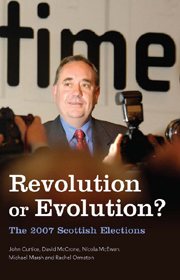Book contents
- Frontmatter
- Contents
- List of Tables
- Preface
- CHAPTER 1 A Watershed Election?
- CHAPTER 2 A Distinctive Scottish Voice? Identities, Values and Attitudes
- CHAPTER 3 What has Devolution Achieved? The Public's View
- CHAPTER 4 Governing Scotland: The People's Preferences?
- CHAPTER 5 Lost Labour Votes? Records, Personalities and Issues
- CHAPTER 6 How the SNP Won
- CHAPTER 7 Do Voters Care about Parties Any More?
- CHAPTER 8 A Personal Vote? How Voters Used the STV Ballot
- CHAPTER 9 Conclusion
- Technical Appendix
- Index
CHAPTER 6 - How the SNP Won
Published online by Cambridge University Press: 12 September 2012
- Frontmatter
- Contents
- List of Tables
- Preface
- CHAPTER 1 A Watershed Election?
- CHAPTER 2 A Distinctive Scottish Voice? Identities, Values and Attitudes
- CHAPTER 3 What has Devolution Achieved? The Public's View
- CHAPTER 4 Governing Scotland: The People's Preferences?
- CHAPTER 5 Lost Labour Votes? Records, Personalities and Issues
- CHAPTER 6 How the SNP Won
- CHAPTER 7 Do Voters Care about Parties Any More?
- CHAPTER 8 A Personal Vote? How Voters Used the STV Ballot
- CHAPTER 9 Conclusion
- Technical Appendix
- Index
Summary
We appear to be left with a considerable puzzle. There was no surge of support for independence in 2007, no sudden swelling of discontent with devolution, and no new rejection of Britishness. Those who were unhappy with Labour's performance in office were less likely to remain loyal to the party, but neither the party nor its leadership was markedly less popular than it had been four years previously. It seems that not only was the SNP's victory historic, but it was achieved in a climate that was not particularly propitious for the party at all.
So how could it have been possible? One possibility, perhaps, is that the party was able to persuade those who had previously stayed at home to back the party this time. The party has previously had some apparent difficulty at getting those who claimed to support it to go to the polls (Paterson, 2006). Maybe, too, the nationalists profited from the large fall in support for the smaller parties, most notably the Scottish Socialists? There were signs in 2003 that those whose discontent with Labour might have led them to back the SNP opted instead to vote for the socialists (Curtice, 2004). Now that the socialists had split into two – the Scottish Socialists and Solidarity – perhaps voting for the nationalists looked like the only effective way of voting against Labour.
- Type
- Chapter
- Information
- Revolution or Evolution?The 2007 Scottish Elections, pp. 104 - 125Publisher: Edinburgh University PressPrint publication year: 2009



